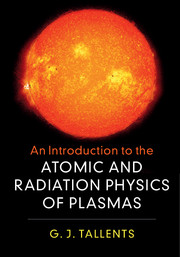Book contents
- Frontmatter
- Contents
- Preface
- 1 Plasma and Atomic Physics
- 2 The Propagation of Light
- 3 Scattering
- 4 Radiation Emission in Plasmas
- 5 Radiation Emission Involving Free Electrons
- 6 Opacity
- 7 Discrete Bound Quantum States: Hydrogen and Hydrogen-Like Ions
- 8 Discrete Bound States: Many-Electron Atoms and Ions
- 9 Discrete Bound States: Molecules
- 10 Radiative Transitions between Discrete Quantum States
- 11 Collisions
- 12 Collisional-Radiative Models
- 13 High-Density Plasmas
- Appendix Vectors, Maxwell's Equations, the Harmonic Oscillator and a Sum Rule
- References
- Index
13 - High-Density Plasmas
Published online by Cambridge University Press: 21 February 2018
- Frontmatter
- Contents
- Preface
- 1 Plasma and Atomic Physics
- 2 The Propagation of Light
- 3 Scattering
- 4 Radiation Emission in Plasmas
- 5 Radiation Emission Involving Free Electrons
- 6 Opacity
- 7 Discrete Bound Quantum States: Hydrogen and Hydrogen-Like Ions
- 8 Discrete Bound States: Many-Electron Atoms and Ions
- 9 Discrete Bound States: Molecules
- 10 Radiative Transitions between Discrete Quantum States
- 11 Collisions
- 12 Collisional-Radiative Models
- 13 High-Density Plasmas
- Appendix Vectors, Maxwell's Equations, the Harmonic Oscillator and a Sum Rule
- References
- Index
Summary
The definition of the necessary density to have a high-density plasma probably depends on the research area of the person seeking the definition. Many regard departure from coronal equilbrium (see Section 12.5) a suitable definition of high density. However, we will consider plasma material at sufficiently high densities to be ‘high density’ if LTE or near-LTE occurs between the ground states of different ionisation stages (see Section 12.7). With LTE conditions, new concepts (not, for example, considered in Chapter 12) often need to be considered. Even with comparatively low temperatures (e.g. a few eV), plasmas formed at high density have a high energy content per unit volume and form a subset of the research field of high-energy density physics [20, 28]. A high-energy density is defined as an energy exceeding 1011 Jm−3 by most authors working in the field (e.g. [20]). Such energy densities are found in materials at solid density and above when temperatures exceed a few eV.
The physics of plasmas at high density requires an understanding of equilibrium relationships. Equilibrium relations are valid at sufficiently high densities which often makes for simpler calculations of plasma ionisation and radiation emission. In plasmas at high density, many interactions can lead to statistical distributions, so that equilibrium ionisation populations and equilibrium radiation distributions as introduced in Sections 1.4.1 and 4.1, respectively, are present. The equilibrium relationships for ionisation and radiation distribution were used to deduce rates of inverse processes by invoking detailed balance (see Chapter 4 for radiative processes and Chapter 12 for collisional processes).
At very high densities and low temperatures, we need to modify the equilibrium ionisation relation (the Saha-Boltzmann equation) as it is necessary to allow for free-electron quantum states becoming fully occupied so that Fermi-Dirac rather than Maxwellian electron energy distribution is required (see Section 13.4). At high density, photons are more likely to interact with particles. However, the Planck black-body radiation distribution does not require modification at high-photon or particle density as photons are bosons and any number can occupy an excitation state.
If the density is high and the temperature of the plasma is not high, the chemical potential and Fermi energy associated with the near-full occupancy of free-electron quantum states are important.
- Type
- Chapter
- Information
- An Introduction to the Atomic and Radiation Physics of Plasmas , pp. 255 - 277Publisher: Cambridge University PressPrint publication year: 2018
- 1
- Cited by

